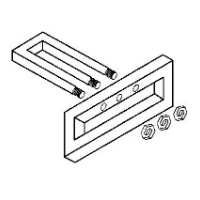Mike Farrell had complicated feelings about B.J. Hunnicutt's mustache
"The mustache was B.J.'s"
When B.J. Hunnicutt is introduced on M*A*S*H in the fourth season, he's depicted as spritely in his duties when he gets to camp, not yet jaded by grueling shifts in the O.R.
Notably, he’s fresh-faced and cleanshaven.
"In the beginning B.J. was cleancut, fresh from home, naïve," actor Mike Farrell told The Auburn Journal in 1980.

Over time, B.J.'s character shifts, with one critic in The Austin American-Statesman in 1979 describing the character as someone "who quickly slid into the sloth-away-from-home surroundings of 'the swamp.'"
To make that shift obvious to the audience, after the sixth season finale episode "Major Topper," B.J. stopped being cleanshaven and began sporting a mustache.
Seeing the facial hair was a message B.J. had become grizzled by his time at camp.
But that mustache became so much more than just a message. From that point forward, B.J.’s mustache became part of fashion.
In the 1970s, mustaches came back in fashion after popular figures like Burt Reynolds, Dick Butkus and Mark Spitz all rocked them with charm, and unlike the Beatles, there was no political message attached to their shaving decisions.
"Barbers became hair stylistics, and beards and mustaches became fashionable," The Chicago Sun-Times reported in a retrospective of the trend published in 1981.
In 1971, The Chicago Daily News dubbed the mustache a "badge of manhood."
One barber interviewed for that story Vincent Di Pinto said it was common for customers to sit in his chair, pull out Burt Reynolds centerfolds for him to reference and request, "Make me look like him."
"They do," Vincent said. "And I have to tell them I'm no plastic surgeon."
On M*A*S*H, B.J.'s mustache got introduced in 1978, right in the midst of this trend that The Chicago Sun-Times quipped was "growing under the nation's noses."
For actor Mike Farrell, B.J.’s mustache also became part of his identity for his time on M*A*S*H, with nearly every interview he did referencing his character’s signature facial hair — which definitely was distinct from the "Burt Reynolds" style.
B.J.'s stache was its own thing.
Farrell struggled with this, because he didn’t completely identify with his character and wanted to be seen as separate from B.J. — and his mustache.
"We’re not the same – although we’re almost exactly the same height," Farrell told The Democrat and Chronicle in 1983. "I think I’m much tougher than B.J.; I'd be much likelier to punch somebody in the nose than he would."
Whether or not it was due to the mustache is uncertain, but after Farrell grew the mustache, he became a household name and his career quickly picked up, being offered more parts.
Too often, though, people just wanted him to do a character just like his mustachioed B.J. Hunnicutt.
That’s why when M*A*S*H ended, for Farrell, that meant the mustache had to go, too.
"The mustache was B.J.'s," he told The Orlando Sentinel in 1983.
Who do you think sported the best Seventies 'stache?




34 Comments

• Tim Donnelly, "Emergency!"
• Dennis Weaver, "McCloud"
• Ted Lange, "The Love Boat"
• Frank Converse, "Movin' On"
• John Ratzenberger, "Cheers"
• Hal Linden, "Barney Miller"
• Harold Gould, "The Mary Tyler Moore Show"
• Alex Trebek, "Jeopardy"
• Dan Rowan, "Rowan & Martin's Laugh-In"
• Rock Hudson, "McMillan and Wife"
The word is spelled SPRIGHTLY.


























































